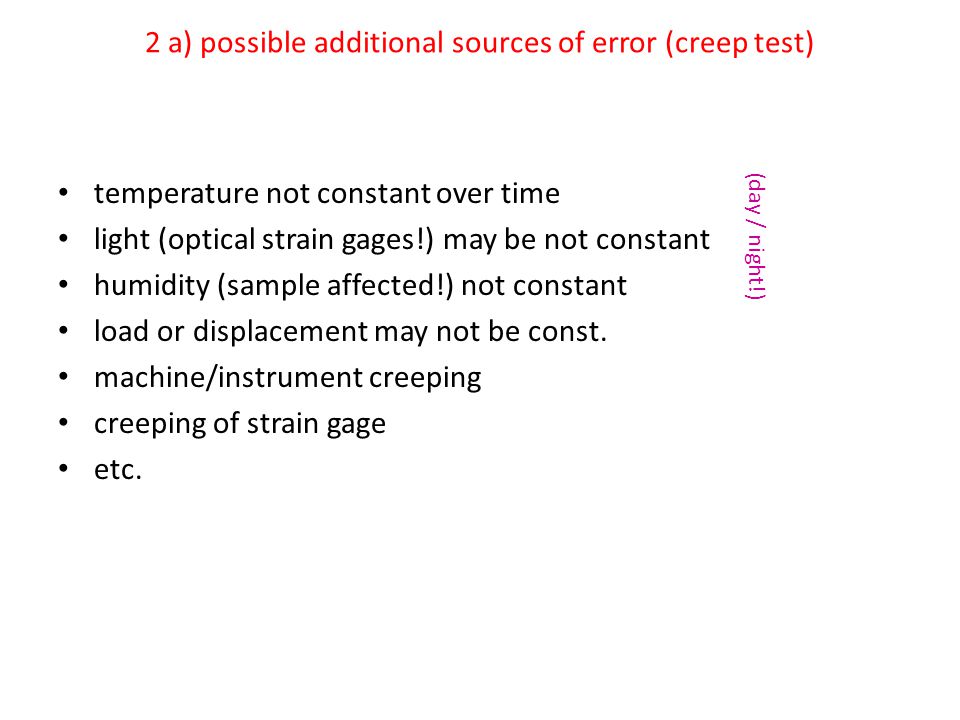What are 2 possible sources of error?
Common sources of error include instrumental, environmental, procedural, and human. All of these errors can be either random or systematic depending on how they affect the results.
What are sources of error?
“Sources of Error” are factors (causes) that may limit the accuracy and/or the precision of experimental results. Sources of error are factors inherent within the experimental set-up and procedures that cannot be “fixed”, no matter how hard you try.
What are the three sources of error?
Physical and chemical laboratory experiments include three primary sources of error: systematic error, random error and human error.
How many types of error are there?
There are three types of errors that are classified based on the source they arise from; They are: Gross Errors. Random Errors. Systematic Errors.
What are the three sources of error?
Physical and chemical laboratory experiments include three primary sources of error: systematic error, random error and human error.
What are the four sources of method error?
When looking for potential sources of error in the lab, consider the 4 Ms – Man, Method, Machine, and Materials. Learn how evaluating these factors can maximize lab efficiency and lab productivity.
What are the sources of error in statistics?
The second axis distinguishes five fundamental sources of statistical error: sampling, measurement, estimation, hypothesis testing, and reporting. Bias is error of consistent tendency in direction.
What is an error Class 11?
The uncertainty in the measurement of a physical quantity is called an error.
Is there a Type 3 error?
Fundamentally, type III errors occur when researchers provide the right answer to the wrong question, i.e. when the correct hypothesis is rejected but for the wrong reason.
What is error and its types explain?
Errors are the difference between the true measurement and what we measured. We show our error by writing our measurement with an uncertainty. There are three types of errors: systematic, random, and human error.
What are the sources of error when using a ruler?
For example, using a ruler often produces random errors because you will not consistently get the ruler's zero line exactly aligned with the edge of the measured object every time you make a measurement. Measurements may display good precision but yet be very inaccurate.
What are the three 3 types of experimental errors?
The three types of experimental error are systematic, random, and blunders.
What are the sources of error in a computer system and?
Four primary sources of error are: (i) roundoff error, (ii) truncation error, (iii) termination of iterations, and (iv) statistical error in Monte Carlo.
What are the sources of error in statistics?
The second axis distinguishes five fundamental sources of statistical error: sampling, measurement, estimation, hypothesis testing, and reporting. Bias is error of consistent tendency in direction.
What are sources of error and uncertainty?
All measurements have a degree of uncertainty regardless of precision and accuracy. This is caused by two factors, the limitation of the measuring instrument (systematic error) and the skill of the experimenter making the measurements (random error).
What are sources of error in reliability?
In order to determine if your measurements are reliable and valid, you must look for sources of error. There are two types of errors that may affect your measurement, random and nonrandom. Random error consists of chance factors that affect the measurement. The more random error, the less reliable the instrument.
What are the three sources of error?
Physical and chemical laboratory experiments include three primary sources of error: systematic error, random error and human error.
What are the seven errors?
The 7 errors game consists of comparing two images, apparently the same, and finding the 7 differences or mistakes between them. Look for the different object, the one that does not appear, the different shape or something in a different colour. Play carefully and visualise the error between the two images.
What is a Type 4 error?
A type IV error was defined as the incorrect interpretation of a correctly rejected null hypothesis.
What is Type 3 and Type 4 error?
A Type III error is directly related to a Type IV error; it's actually a specific type of Type III error. When you correctly reject the null hypothesis, but make a mistake interpreting the results, you have committed a Type IV error.
What are the three sources of error in the indirect method?
There are three sources of error in the indirect measurement of blood pressure: (1) observer bias, (2) faulty equipment, and (3) failure to standardize the techniques of measurement.
What is one type of error?
A Type I error means rejecting the null hypothesis when it's actually true. It means concluding that results are statistically significant when, in reality, they came about purely by chance or because of unrelated factors. The risk of committing this error is the significance level (alpha or α) you choose.
What type of error is name error?
The syntax is missing double quotation marks for text values If the syntax omits double quotation marks “” for a text value, you will see the #NAME error.
What are the 3 main errors in Python?
There are three basic types of errors that programmers need to be concerned about: Syntax errors, runtime errors, and Logical errors.
What are sources of error in reliability?
In order to determine if your measurements are reliable and valid, you must look for sources of error. There are two types of errors that may affect your measurement, random and nonrandom. Random error consists of chance factors that affect the measurement. The more random error, the less reliable the instrument.
What are sources of error and uncertainty?
All measurements have a degree of uncertainty regardless of precision and accuracy. This is caused by two factors, the limitation of the measuring instrument (systematic error) and the skill of the experimenter making the measurements (random error).

